By JULIE MINDA
Colleen Stiles, 78, was as excited as a schoolgirl last month when the kids returned to the elementary school classroom in Billings, Montana, where she works with children who need a boost with academic or developmental skills.
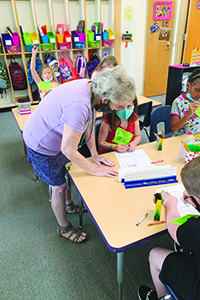
Colleen Stiles, a foster grandparent in a fourth-grade classroom at Orchard Elementary School in Billings, Montana, aids a student during the first day of the school year. St. Vincent Healthcare of Billings provides schools with foster grandparents to help struggling students.
She is one of the two dozen-plus mentors who St. Vincent Healthcare of Billings is providing to area school districts through its AmeriCorps Senior Foster Grandparent Program. Demand for foster grandparents exceeds supply, so the health system hopes to hire and dispatch at least a dozen more of these classroom helpers whose goal is to provide extra nurturing and put young children on firmer educational footing.
Most of the grandparents work in Head Start centers, early childhood education centers and elementary schools in low-income areas.
The benefits of the program flow to young and old. Stiles, a foster grandparent in a fourth-grade classroom at Billings' Orchard Elementary School, says working with the children keeps her mind sharp. "This gives me a purpose and improves my health. And, I get the nicest notes from the kids."
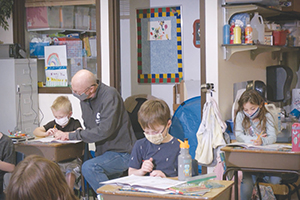
Foster grandparent Bruce Albers, shown here assisting a student at Eagle Cliffs Elementary in Billings, Montana, is working with second grade students at Bitterroot Elementary in Billings this school year.
Once she recovers from a recent surgery, foster grandparent Rosemary Peak, 87, plans to be back working with 3-, 4- and 5-year-olds in the Head Start program at the Ramona King Center in Hays, population 843. Peak is related to the two other foster grandparents who work at the rural center.
She's a member of the Assiniboine tribe and lives on the Fort Belknap Indian Reservation about a mile up the road from the center in north central Montana. Many of the children in her Head Start program are members of her tribe or the Gros Ventre tribe, which shares the reservation. Elders are esteemed in tribal culture so Peak's generous praise and attention for students can raise their self-esteem and build a positive attitude about learning.
Peak says the kids crave her attention, clambering to sit on her lap and play and their joy makes her heart light. The kids call her Grandma Bunny — a childhood nickname she got from her family that has stuck with her. One student called her Grandma Rabbit. "I love going to the school. And the kids just love me — they call to me when I come in, and I get lots of hugs," she says.
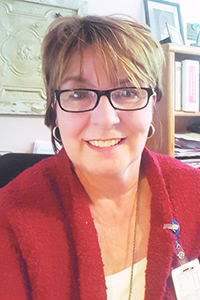
Barbara Brady
One-on-one attention
Kids in classrooms with foster grandparents get personal attention that may be difficult for teachers to provide. Barbara Brady, director of the Foster Grandparent Program at St. Vincent, says while some rural classrooms may have just a few students per class, Billings-area classrooms typically have upwards of 20 students each. (Brady is departing the role she has held for 21 years at the end of this month.)
The foster grandparents work with native and non-native children who lag in reading, math and social or emotional development, as determined by the teacher through testing or observation. Some of the children are faring poorly because they are homeless, in foster care or experiencing family trauma, says Brady.
To be considered to host a foster grandparent, teachers must identify the particular child or children in their classroom who would benefit from a foster grandparent and document the specific needs such as ongoing academic or emotional struggles.
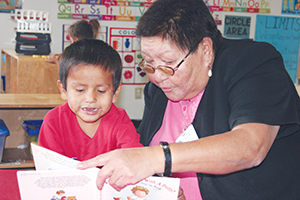
Myrna Burgess is a foster grandparent at the Northern Cheyenne Head Start program on the Northern Cheyenne Indian Reservation in southeastern Montana. She is a "chief child" — her father was a Cheyenne chief. This photo was taken prior to the pandemic.
When the request and candidate availability align, Brady matches the foster grandparent with a teacher and with a specific child or children in that classroom. Then, the school and Brady draw up a nonbinding memorandum of understanding that spells out responsibilities and can be renegotiated every three years. They also agree on an assignment plan that clearly states the grandparent's schedule, duties and goals.
Foster grandparents can branch out to interact with children in other classrooms, but they concentrate on the child or children they've been matched with each school year. It is typical for foster grandparents to continue with the same teacher or with the same grade level year after year.
The foster grandparent, who must be at least 55 years of age and pass a background check, commits to work at least 12 hours per week in the classroom, but can choose to work up to 40 hours.
To qualify for a $3 per hour stipend for their service, an applicant's income must be at or below 200% of the federal poverty level.
Wraparound services
Brady says most of the foster grandparents have incomes at or below 130% of the poverty level. She says she is a resource to these individuals, helping them access supports they need from St. Vincent and partner organizations. For instance, Brady helped one foster grandparent who couldn't pay her rent find more affordable temporary housing. Brady worked with the St. Vincent Foundation to get gift cards and funding to hold the woman over financially until she could get into an apartment she could afford.
Brady tries to place new hires at schools and education centers in their own communities. She's found that many prefer the shorter drives, especially in winter, and many like to work in the school that they or their children attended.
Trusting relationship
Billings' Broadwater Elementary, a school with a large proportion of low-income families, has hosted St. Vincent's foster grandparents for decades. Principal Justin Huck says some children arrive for kindergarten never having learned their ABCs.
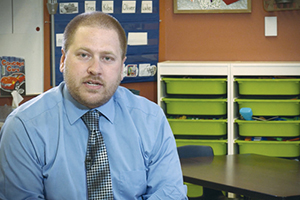
Justin Huck
Carrie Langford, the one foster grandparent who was active at the school last year, worked remotely for part of the year because of the pandemic. The school closed in spring 2020 to in-person instruction and then resumed in-person at the start of the 2020-2021 school year. While Langford is not returning this year, Huck is working with the program to identify a new foster grandparent for Broadwater.
He says one of the greatest benefits of having a foster grandparent in the classroom at Broadwater is that students can build relationships with a responsible, caring adult — a positive role model. He says in an orientation video for the program: "You have another person who can work with those students one on one, or with small groups of students, doing some flashcards, reading to them."
Brady says many teachers claim that the biggest benefit of having a foster grandparent in the classroom is their ability to encourage students, help keep them on task and to be there emotionally for them.
Life goes on
AmeriCorps, a federal agency that tackles pressing U.S. concerns through national service and volunteering, provides $242,470 in grants for the program. St. Vincent adds a 10% match annually in community benefit dollars, and lends administrative support. Its foundation contributes an additional $27,000. The budget supports staff costs for the program's director and part-time assistant, foster grandparents' stipends, mileage reimbursement and trainings.
Normally, the program funds up to four dozen foster grandparents through St. Vincent. That count has been as low as 27 over the past year. A number of those foster grandparents videoconference with students during COVID-driven school closures.
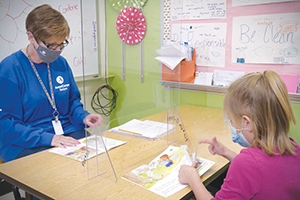
Foster grandparent Audrey Kemp reads with a child in a first grade classroom at Eagle Cliffs Elementary in Billings.
This year Billings-area schools in the foster grandparent program are all expected to start the year with in-person instruction. Brady says any foster grandparent who wants to return to the classroom will be able to do so, at least for now. She is monitoring COVID caseloads in the community and will determine if changes are needed.
Foster grandparents wear St. Vincent name badges while in the classroom, and Brady says St. Vincent shares in the goodwill they engender.
Brady says she loves to hear from the senior adults how being a foster grandparent has improved their lives. "The program gets in their hearts. They get hugs from the kids; they get thank-yous from teachers; they are recognized in the grocery store.
"They experience the value of feeling like they are needed," she says. "When many people are older and perhaps retire, they feel like they lose their identity. This program shows that just because someone gets older, doesn't mean their life has to stop."
St. Vincent documents program's academic benefits for students
The Foster Grandparent Program from St. Vincent Healthcare of Billings, Montana, is improving the academic performance of struggling students, according to Barbara Brady, its outgoing director.
In the last full school year that was not interrupted by the pandemic — the 2018-2019 school year — 45 foster grandparents interacted with 496 students, either one-on-one or in small groups. For that school year, pre- and post-testing found that 79%
of these students showed academic improvement.
During the pandemic-related school closures, 23 foster grandparents compiled project assignments that were given to kids in an early childhood program, and all
230 children who received such assignments showed academic gains. And 90% of 130 elementary school children who interacted virtually with 12 foster grandparents showed academic gains, according to Brady.
A 2019 study of AmeriCorp Senior volunteers, including foster grandparents from the St. Vincent Healthcare Foster Grandparent Program, found that these volunteers self-reported improved or stable health, reduced depression, reduced isolation and improved feelings of having companionship, as compared to senior adults who did not volunteer. The federal agency the Corporation for National and Community Service funded the study.
A companion study found that the caregivers of the AmeriCorp Senior volunteers reported getting more respite and saw their own health improve due to gaining personal time when the senior adults were away from home in their foster grandparent roles.
St. Vincent was early champion of Foster Grandparent Program
The Foster Grandparent Program began in the 1960s as a federal initiative that was part of the Lyndon B. Johnson administration's expansive legislative initiative known as the "war on poverty." The organization that today is called St. Vincent Healthcare became Montana's first Foster Grandparent Program host site in 1971. At that time, the foster grandparents visited children at the Billings, Montana, hospital.
When the government moved to transfer program oversight to the private sector in the 1980s, the Sisters of Charity of Leavenworth, who sponsored St. Vincent at the time, volunteered for the hospital to take over its leadership to ensure its continuation.
In 1993, the federal government resumed oversight of the Foster Grandparent Program, incorporating it under its newly created AmeriCorps. That national and community service agency continues the federal administration of the program today.